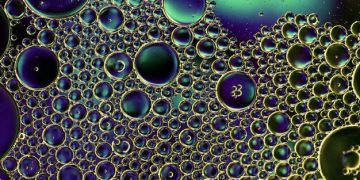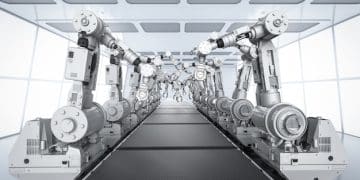Nanotechnology: Applications and Impact on US Industries

Nanotechnology is revolutionizing numerous US industries by manipulating matter at the atomic and molecular levels, yielding innovative products and processes with enhanced functionalities and efficiency.
The realm of nanotechnology: applications and implications for US industries is vast and rapidly evolving. This innovative field, manipulating matter at the atomic and molecular scales, has the potential to reshape how various sectors operate within the United States. Let’s delve into the transformative impact of nanotechnology across key US industries.
Understanding nanotechnology and its fundamental principles
Nanotechnology, at its core, involves the manipulation of matter at the nanoscale, typically between 1 to 100 nanometers. At this scale, materials exhibit unique physical, chemical, and biological properties that differ significantly from their macroscopic counterparts. This section explores the underlying principles that make nanotechnology a groundbreaking field.
Key Nanoscale Properties
At the nanoscale, quantum effects become more pronounced, influencing properties like conductivity, magnetism, and reactivity. These enhanced properties enable the creation of novel materials and devices with superior performance.
Nanomaterial Fabrication Techniques
Various techniques are employed to fabricate nanomaterials, including top-down approaches like lithography and etching, as well as bottom-up methods such as self-assembly and chemical synthesis. Each technique offers distinct advantages depending on the desired material and application.
- Self-Assembly: Molecules spontaneously organize into ordered structures.
- Chemical Synthesis: Precisely engineered reactions create nanoparticles.
- Lithography: Patterns are etched onto surfaces for nanoscale circuits.
The ability to engineer materials at such a minute scale opens doors to creating incredibly precise and efficient products. The unique properties observed at the nanoscale are not merely scaled-down versions of macroscopic properties; they represent entirely new behaviors that can be harnessed for technological advancement.

The impact of nanotechnology on the healthcare industry
Nanotechnology is transforming the healthcare sector by enabling more effective diagnostics, targeted drug delivery, and regenerative medicine. This section examines the diverse applications of nanotechnology that are leading to significant improvements in patient care and treatment outcomes.
Nanoparticle Drug Delivery Systems
Nanoparticles can be engineered to encapsulate drugs and deliver them directly to target cells, minimizing side effects and enhancing therapeutic efficacy. This precision delivery system is particularly promising for cancer treatment.
Nanoscale Diagnostics and Imaging
Nanosensors and nanoimaging agents are being developed to detect diseases at early stages with greater sensitivity and accuracy. These tools provide real-time monitoring and improved diagnostic capabilities.
- Early Detection: Nanosensors identify biomarkers at the molecular level.
- Targeted Therapies: Drugs are delivered precisely to diseased cells.
- Regenerative Medicine: Nanomaterials promote tissue repair and regeneration.
Nanotech-based innovations promise more personalized and effective healthcare solutions. With the ability to intervene at the molecular level, nanotechnology is poised to revolutionize how diseases are diagnosed and treated, leading to healthier and longer lives.
Nanotechnology in electronics and computing
Nanotechnology is driving innovation in the electronics and computing industries, leading to smaller, faster, and more energy-efficient devices. This section highlights the advancements in nanomaterials and nanodevices that are shaping the future of computing and electronics.
Nanotransistors and Nanocircuits
Nanotransistors are significantly smaller than traditional silicon transistors, enabling higher densities on integrated circuits. This increased density translates to faster processing speeds and reduced power consumption.
Quantum Computing with Nanomaterials
Nanomaterials are being explored for use in quantum computing, which could revolutionize computation by solving complex problems beyond the capabilities of classical computers. Quantum dots and nanowires are key components in these emerging technologies.
Nanotechnology could be a pathway to more powerful and efficient computing devices. By pushing the boundaries of miniaturization and exploring quantum phenomena, nanotechnology is set to unlock new levels of performance in electronics and computing.
Nanotechnology applications in energy and environmental sustainability
Nanotechnology is playing a crucial role in addressing energy and environmental challenges, offering solutions for more efficient energy generation, storage, and pollution remediation. This section explores how nanotechnology is contributing to a more sustainable future.
Nanomaterials for Solar Energy
Nanomaterials such as quantum dots and nanowires are enhancing the efficiency of solar cells by improving light absorption and energy conversion. These advancements are making solar energy more cost-effective and accessible.
Nanofiltration for Water Purification
Nanofiltration membranes, made using nanomaterials, are capable of removing pollutants and contaminants from water with high efficiency. This technology is vital for providing clean and safe drinking water in areas with limited resources.
- Efficient Solar Cells: Nanomaterials boost energy conversion rates.
- Clean Water: Nanofiltration removes pollutants effectively.
- Energy Storage: Nanocomposites improve battery performance.
Nanotechnology is enabling the creation of more efficient solutions for energy generation, conservation, and environmental remediation. As the demand for clean energy and sustainable practices grows, the role of nanotechnology in these areas will become increasingly vital.

The role of nanotechnology in manufacturing and materials science
Nanotechnology is revolutionizing manufacturing and materials science by enabling the creation of stronger, lighter, and more durable materials. This section examines how nanotechnology is enhancing material properties and manufacturing processes.
Nanocomposites for Enhanced Material Strength
Nanocomposites, materials that incorporate nanoparticles, exhibit superior mechanical, thermal, and electrical properties compared to conventional materials. These enhanced properties make nanocomposites ideal for use in aerospace, automotive, and construction industries.
Additive Manufacturing with Nanomaterials
Nanomaterials are being integrated into additive manufacturing processes, such as 3D printing, to create complex and customized parts with high precision. This integration opens up new possibilities for product design and manufacturing.
- Stronger Materials: Nanocomposites enhance durability and performance.
- Precision Manufacturing: Nanomaterials enable fine-tuned production.
- Lightweight Designs: Nanomaterials reduce weight without sacrificing strength.
Nanotechnology is facilitating the creation of advanced materials and manufacturing techniques that were previously unattainable. By enhancing material properties and enabling precise fabrication, nanotechnology is driving innovation across multiple sectors.
Ethical and societal implications of nanotechnology
As nanotechnology continues to advance, it is crucial to consider the ethical and societal implications of its development and deployment. This section addresses some of the potential risks and benefits associated with nanotechnology and the importance of responsible innovation.
Environmental and Health Risks
The widespread use of nanomaterials raises concerns about their potential impact on the environment and human health. Proper risk assessment and management are essential to ensure the safe handling and disposal of nanomaterials.
Socioeconomic Impacts
Nanotechnology has the potential to create new jobs and industries, but it could also exacerbate existing inequalities. Ensuring equal access to the benefits of nanotechnology and addressing potential job displacement are important considerations.
- Risk Assessment: Thorough evaluation of potential hazards.
- Ethical Guidelines: Development of responsible innovation practices.
- Public Engagement: Open dialogue on the societal impacts of nanotechnology.
Addressing the ethical and societal implications of nanotechnology is essential for ensuring that its benefits are realized while minimizing potential risks. Responsible innovation, guided by ethical principles and public input, will be critical for shaping the future of nanotechnology.
| Key Point | Brief Description |
|---|---|
| 🔬 Nanomaterials | Materials engineered at the nanoscale, exhibiting unique properties. |
| ⚕️ Healthcare | Targeted drug delivery, enhanced diagnostics, and regenerative therapies. |
| ⚡ Electronics | Smaller, faster, and more energy-efficient computing devices. |
| 🌱 Sustainability | Efficient energy generation, water purification, and pollution control. |
Frequently Asked Questions About Nanotechnology
▼
Nanotechnology is the manipulation of matter at the atomic and molecular scale. It involves creating and using materials, devices, and systems with unique properties because of their small size (1 to 100 nanometers).
▼
In medicine, nanotechnology is used for targeted drug delivery, enhanced imaging, and regenerative medicine. Nanoparticles can deliver drugs directly to cancer cells, improving treatment effectiveness and reducing side effects.
▼
Nanotechnology is used in environmental applications for water purification, air pollution control, and energy efficiency. Nanomaterials can filter contaminants from water and improve the efficiency of solar cells, contributing to sustainability.
▼
Potential risks include environmental and health hazards due to the unique properties of nanomaterials. It’s essential to conduct thorough risk assessments and implement safety measures to minimize exposure and ensure responsible development.
▼
Nanotechnology leads to smaller, faster, and more energy-efficient electronic devices. Nanotransistors and quantum dots are used to increase processing speeds and reduce power consumption, enabling advancements in computing and communication technologies.
Conclusion
Nanotechnology stands as a transformative force across US industries, driving innovations in healthcare, electronics, energy, and manufacturing. While its potential benefits are vast, responsible development and ethical considerations are critical to ensuring its safe and equitable deployment, paving the way for a future where nanotechnology enhances both economic growth and societal well-being.





